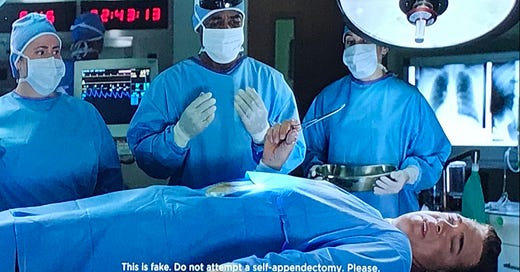Why do we put those stupid little danger warnings at the bottom of commercials?
Like pretty much every other popular sub-phenomenon on Earth, commercials in recent years have become increasingly geared toward the metrics of social media. I feel like every commercial these days has to have a shtick of some kind. Do you know what commercials were like if you were growing up in the mid-1990s? You had a kid playing with some Micro Machines, you had a lady grinning like crazy as she picked up a box of Hamburger Helper at the supermarket, maybe if you were lucky you got a pro football player plugging a snack or a cleaning product or something. Nobody was creative back then. It was a struggle just to earn enough money to keep from starving. These were different times.
One of the most common features of modern commercial is those tiny little warnings near the bottom of the screen. You know them. You’ll see a guy launching his Kia Sorento across the Grand Canyon and down at the foot of the screen is a smidge of text in 11-point font: “Do not attempt.” Some guy takes a bite of a WaWa hoagie and it’s so good that he uses a car jack to crank open his mouth so he can fit the whole sandwich in at once. At the bottom: “Fictional. Please do not stick a car jack in your mouth.” A lady loves the smell of Tide detergent so much that she climbs into the washer to enjoy a cycle of the stuff. Disclaimer: “Dangerous. Do not attempt.”
I gotta ask: Is this necessary? I mean really? Do we really need to tell people not to do these things? Am I overthinking this? I don’t think this is too complicated. I don’t think you need to tell anyone not to get into a washing machine and drown themselves in Tide. I think the people you do need to tell that to aren’t going to care about a little disclaimer at the bottom of the commercial; they’re just going to do it no matter what. I mean think about it: How many people do you know, or how many people have you ever even met, who might be (a) genuinely tempted to climb in a washing machine and (b) dissuaded from doing so because a corporate lawyer plastered a stupid warning in 11-point font at the bottom of the commercial? Like how many people do you have in your life like that? Is it even one?
You have to be careful about making these sorts of cultural criticisms. You can end up sounding like Jeff Foxworthy if you don’t watch it. You know what I mean: Just sort of an inchoate grumbling about a thing, a low-information redneck riff on something instead of an actual instance of genuine critique. “I dunno what the world’s comin to, man. When I was young we smoked cigarettes at 10 years old and we didn’t think twice bout the surgeon general warning. Mostof us didn’t know any surgeons or generals! Heh heh heh!” This isn’t like that at all. It’s a serious question: Why is this stuff necessary? What purpose does it serve? Who does it help?
I guess the most obvious answer is the companies themselves. It gives them a liability shield in case a guy tries to do something stupid that he saw on a commercial. Which, okay. I guess that makes sense. If a dunderheaded consumer took them to court because he tried to cook a steak on a clothing iron and set his house on fire, I suppose they’d have plausible deniability: “Your Honor, we included a disclaimer at the bottom of the commercial: ‘Do not fry steak on clothing irons.’ We’re airtight.” But at what point does a legal system just sort of discard the formalities of evidentiary prerequisite? If a judge will nail a company to the wall if they didn’t include a tiny disclaimer at the bottom of the spot, why won’t he nail them even if they included it? If we’re so willing to indulge the stupidity of the lowest common denominator that it’s come to this, why can’t it easily go beyond this? What’s the limiting principle here? The disclaimer? Really?
I just don’t understand it. Maybe it’s because I’d never do any of this idiotic stuff in the first place. Of course, maybe it really is the disclaimers that stop me from wanting to do those things. Maybe I should be more grateful for them.



